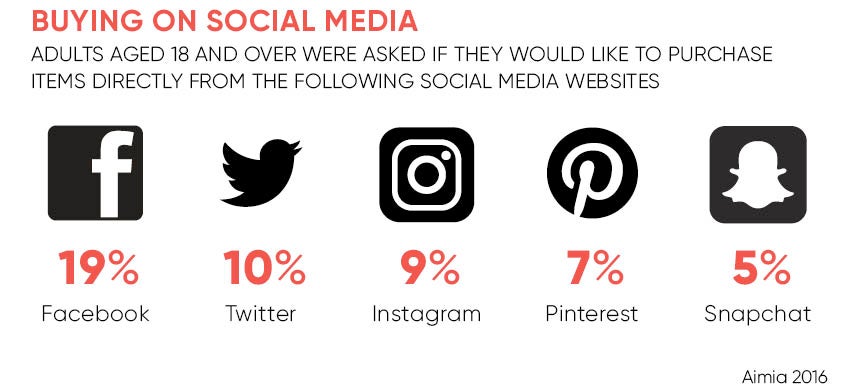Until recently social media platforms such as Facebook, Pinterest and Twitter were viewed as ideal channels for building brand awareness. Now they are becoming a powerful tool for accessing that hard-to-reach demographic of young, engaged buyers and increasingly converting those users into directly purchasing a product.
Could the growing phenomenon of social shopping be the future of e-commerce? The short answer is “yes”, says Kieron Weedon, director of strategy at retail marketing agency BWP Group. “The very nature of social media – the ability to share, recommend and show products to friends and peers – shortcuts the comparison shopping customer journey. Facilitating the purchase of products directly from that social media platform was the next natural step.”
But if they are to reap the huge reputational and financial benefits of social shopping, retailers must find a way of changing the consumer mindset that social media is only there for a quick tweet or snap.
Naji El-Arifi, head of innovation at global e-commerce consultancy Salmon, says: “Shoppers will always want a better experience that is easily accessible, and Facebook and Twitter can offer the platform to do this. The foundation for social shopping to succeed is already there – Facebook is already testing it with Facebook Marketplace – it’s up to the boldest retailer to take note, provide a strong customer service and implement a strategy that integrates social media into the overall online offering.”
The challenges
While social shopping offers huge potential for the retail industry, evidence is still scarce to suggest that it is gaining traction. Rachel Barton, managing director, advanced customer strategy, at Accenture Strategy, says although social media is revenue ready, the majority of organisations have barely tapped into an omnichannel model that integrates social in a meaningful way.
“Moving beyond ‘like’ to ‘buy’ is no easy task,” she says. “It’s not about offering consumers the same buying experience they receive through traditional e-commerce. Success requires redefining the shopping experience for a new medium, and making it effortless and tailored for the customer.”
Already ahead of the social shopping game is WeChat, the messaging app in China that has been described as WhatsApp, Amazon, Deliveroo, Uber and more all rolled into one. It is also becoming a central hub for online merchants. Comparisons to Facebook are being drawn, particularly in light of its marketplace features and enhanced messaging services, but most e-commerce experts agree that in reality, no app in the West comes close to WeChat’s ubiquitous quality.
Becky Carré, PPC (pay-per-click) executive at e-commerce agency Impression, says: “WeChat’s apps-within-an-app model, including peer-to-peer marketplaces and payment functionality, could present a challenge to the West’s social media giants, particularly as Facebook users become disenchanted with the platform and engagement declines. However, with a number of social media platforms blocked in China, Facebook included, WeChat’s popularity could be attributed simply to its lack of competition.”
It’s not about offering consumers the same buying experience they receive through traditional e-commerce
Widespread adoption of WeChat’s business model by Western platforms also faces a major barrier, as Jon Carney, chief digital officer, McCann Worldgroup, Europe, the Middle East and Africa, explains: “The West lacks a crucial piece of infrastructure that China has – one or two dominant, mobile-optimised checkout gateways with mass adoption. Our mobile payments are currently much more fragmented and without a default integrated checkout gateway, the social networks will struggle to grow retail activity. However, this isn’t insurmountable and once a two-horse race emerges I can see rapid development of impulse-driven, mobile social commerce.”

‘Buy’ instead of ‘like’
There is no question that social shopping has a huge role to play as consumers shift their buying preferences from desktop, to tablet, to mobile phones. The move towards “buy buttons” being embedded in social platforms such as Instagram and Pinterest is a natural extension of people wanting the Uber experience of a seamless, secure shopping experience. However, as Dennis Jones, chief executive of Judopay, points out, not all platforms are likely to succeed, as the likelihood of hitting “buy” is tied to the mind-frame consumers have when using social platforms.
“Twitter recently shut down their buy button and we don’t anticipate Facebook experiencing more than moderate success with theirs,” he says. “While some purchases are highly impulsive, others require more investigation and are best satisfied with a more immersive brand experience, for example to read reviews of a dress or check a return policy. To make this buying experience as seamless as that offered by the best companies takes time, but it will happen.”
What we are seeing, says Mr Jones, isn’t strictly a move to social shopping, rather the natural evolution from m-commerce into app commerce.
“Our favourite websites have long become ‘appified’, and we are interacting with Facebook, Twitter, Amazon and even Netflix from our mobiles. Consumers now expect a premium app-style experience. It’s unlikely that the West will adopt the ‘one-stop shop’ app approach of WeChat, so it’s vital brands are offering seamless purchasing across all the channels their customers care about.”
The challenges

